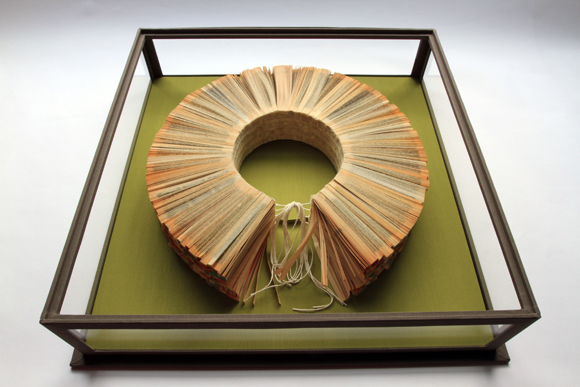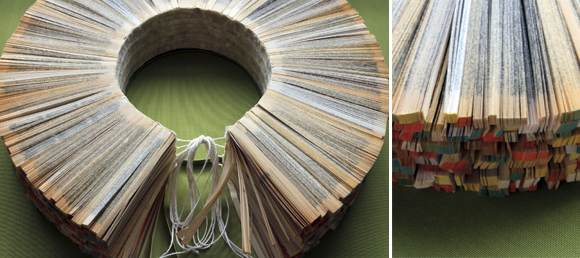
Slices of paperback books, cheese cloth, string, bookbinders glue, binders board, museum board, bookbinding cloth, acrylic panels

Slices of paperback books, cheese cloth, string, bookbinders glue, binders board, museum board, bookbinding cloth, acrylic panels
Edition of 15 with 3 Artist's Proofs (#14 pictured above; #10 below)
Outside circ"umference 13 3/4 inches, inside circumference 5 1/2 inches, depth 2 1/2 inches
(16 3/4 inches length if laid straight)
Box dimensions: 18 7/8 inches square, 4 1/2 inches high
Archival box produced by Culpeck & Clark Limited, Rhinebeck, New York
"The circle of the hand making is the first eye. It is the empty center in the tower, the clearing in the forest, where with the fundaments of cloth and paper and line we weave and re-weave unending relations."
carriage is an edition produced in conjunction with the 2009 installation human carriage for the Guggenheim's "The Third Mind: American Artists Contemplate Asia, 1860-1989." The fifteen works in the edition further transformed one of the installation's core components: the “guillotined” book fragments reconstructed into weights that propelled a bell carriage down the a spiral pipe of the Guggenheim's parapet walls. The book weights and their journey responded to the vast bibliography of translated Asian literary and philosophical texts that are primary sources used by many American artists to understand the East.

human carriage investigated the processes of circulation, transmission, interpretation, appropriation, and misunderstanding of these texts through this “materialization of reading,” in which cross-sections of multiple books run as veins through newly made artifacts. Still hinged at the spine but now free to fan out, move, and be combined in new forms, these fragments were layered, with spines glued to a cheesecloth backing to create a ring-shaped object or collar that retained the language and references of a book while evoking other associations: the bhavacakra (wheel of life); the spiral of the Guggenheim; and the Zen Buddhist enso (Japanese word for “circle”) paintings which can imply many things at once—completeness, nothingness, the absolute, the enlightenment with no beginning/no end in all phenomena.
This interest in the circle as form is influenced deeply by Ralph Waldo Emerson’s essay CIRCLES. It begins:
The eye is the first circle; the horizon which it forms is the second; and throughout nature this primary figure is repeated without end. It is the highest emblem in the cipher of the world. St. Augustine described the nature of God as a circle whose centre was everywhere, and its circumference nowhere. We are all our lifetime reading the copious sense of this first of forms. One moral we have already deduced, in considering the circular or compensatory character of every human action. Another analogy we shall now trace; that every action admits of being outdone. Our life is an apprenticeship to the truth, that around every circle another can be drawn; that there is no end in nature, but every end is a beginning; that there is always another dawn risen on mid-noon, and under every deep a lower deep opens.
Structurally, strings between the cheesecloth and spine provide a “handle” or “tie” that mimiced the way book fragments were constructed to act as counter-weights within the museum installation. The collar, made using the traditional materials of bookbinding, is housed in a transparent box that both protected and serves as its display case.

Photo credit: Jenny Fine